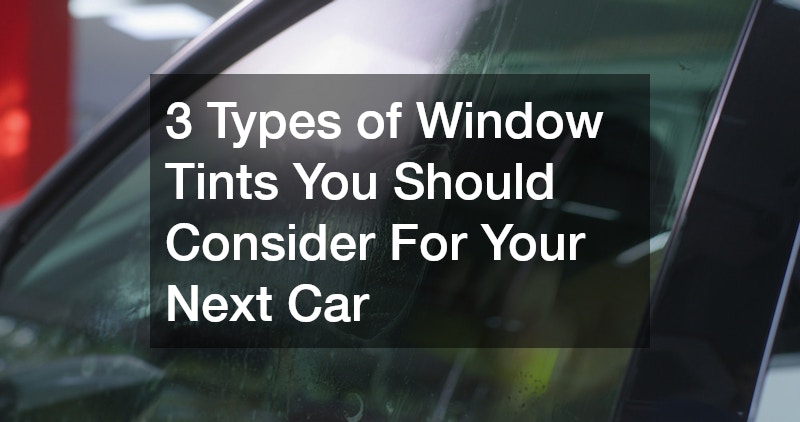Window tinting is one of the most practical and visually striking upgrades you can make to your vehicle. Not only does it enhance the aesthetic appeal, but it also improves comfort, privacy and safety.
Whether you’re purchasing a new car or considering updates to your current vehicle, choosing the right type of tint can make all the difference.
With several options available on the market, understanding the strengths of each type of tint is essential to making an informed decision. This guide outlines three of the most common types of car window tints to consider for your next vehicle upgrade.
Dyed Window Tint: A Budget-Friendly Option With Style
Dyed window tint is often the first choice for vehicle owners looking for an affordable way to improve the appearance and function of their windows. This type of tint uses a layer of dye between an adhesive layer and a protective top coating. The dye absorbs solar heat and reduces glare, providing immediate comfort for drivers and passengers.
One of the standout benefits of dyed tint is its matte appearance, which gives vehicles a clean, understated look. It’s particularly effective at increasing privacy, as it darkens the windows significantly from the outside while maintaining visibility from the inside during daylight hours.
However, dyed tints may not last as long as some of the more premium options. Over time, exposure to harsh sunlight can cause the dye to fade or change colour. While this won’t affect the tint’s basic function immediately, it can diminish the overall appearance and may lead to replacement sooner than other materials.
If you’re seeking a cost-effective solution that delivers solid heat and glare reduction, dyed film is a strong contender. It’s also ideal for those who are new to tinting and want to explore the benefits before investing in higher-end options.
Metalised Window Tint: Enhanced Durability and UV Protection
For drivers looking for performance as well as style, metalised window tint is worth considering. This type of tint incorporates tiny metallic particles layered into the film, which reflect sunlight and heat away from the vehicle. The result is a significant drop in interior temperatures, even during Australia’s hot summer months.
Aside from heat resistance, metalised films also offer added strength to your car windows. The metallic layer reinforces the glass, helping it resist shattering during impact. This added layer of safety is particularly valuable for families or those who spend long hours on the road.
In addition, metalised window tinting can significantly reduce ultraviolet (UV) radiation exposure. UV rays are a leading cause of fading upholstery, dashboard deterioration and even skin damage. Metalised films help preserve your car’s interior while also protecting occupants from harmful sun exposure.
One point to keep in mind is that the metal layer may interfere with electronic signals. This could potentially affect mobile phone reception, GPS or radio signals. If your vehicle heavily relies on these technologies, you may want to test compatibility before committing to this option.
Ceramic Window Tint: Premium Performance and Clarity
Ceramic window tint represents the top tier of window film technology. While typically more expensive than dyed or metalised options, it offers superior performance in nearly every category. Unlike metalised films, ceramic tints are made using non-metallic, nano-ceramic particles that are invisible to the naked eye.
This innovative material allows ceramic tints to block up to 99 per cent of UV rays and a high percentage of infrared light, which is responsible for most of the heat you feel inside the car. This not only improves comfort but also reduces strain on your vehicle’s air conditioning system, potentially enhancing fuel efficiency over time.
Ceramic films are also extremely durable. They resist fading, bubbling and discolouration even in harsh Australian climates, maintaining their appearance and function for years to come. While the upfront cost may be higher, the long-term value and peace of mind often justify the investment.
Choosing the Right Tint for Your Needs
When selecting the best tinting option, it’s important to weigh the benefits of each type against your specific needs, budget and driving habits. Are you mostly concerned with appearance? Do you need maximum heat resistance and UV protection? Or are you looking for a long-term investment in comfort and safety?
Your lifestyle should guide your choice. For example, if you park your vehicle outdoors most days, a ceramic film may provide the superior protection you need. On the other hand, if you’re after a sleek look without breaking the bank, dyed film might be the ideal starting point. Metalised tints offer a balanced solution, delivering performance benefits at a mid-range price point.
Window tinting is far more than an aesthetic upgrade—it’s a functional investment in your vehicle’s longevity, your comfort and your health. By understanding the differences between dyed, metalised and ceramic films, you’ll be better equipped to choose a solution that matches your lifestyle and expectations.
.

